Geometric Shape Induced Small Change of Seebeck Coefficient in Bulky Metallic Wires
Abstract
:1. Introduction
2. Experimental Details
2.1. Preparation of Type-U Samples
2.2. Preparation of Split Samples
2.3. Preparation of Pressed Samples
2.4. Preparation of Thick-Wire, Thin-Wire Dual-Arm Samples
3. Results
3.1. Results of Grinded Type-U and Split Samples
3.2. Results of Pressed Samples
3.3. Calibration Results of “Identical Wire” Samples
3.4. Prototype High-Temperature Sensors, Thick-Wire, Thin-Wire Dual-Arm Samples
4. Discussion
5. Conclusions
Acknowledgments
Author Contributions
Conflicts of Interest
References
- International Roadmap Committee. International Technology Roadmap for Semiconductors; Semiconductor Industry Association: San Francisco, CA, USA, 2013. [Google Scholar]
- Chaudhry, A. Interconnects for nanoscale MOSFET technology: A review. J. Semicond. 2013, 34, 066001. [Google Scholar] [CrossRef]
- Nie, Z.; Nijhuis, C.A.; Gong, J.; Chen, X.; Kumachev, A.; Martinez, A.W.; Narovlyansky, M.; Whitesides, G.M. Electrochemical sensing in paper-based microfluidic devices. Lab Chip 2010, 10, 477–483. [Google Scholar] [CrossRef] [PubMed]
- Kim, B.J.; Meng, E. Review of polymer MEMS micromachining. J. Micromech. Microeng. 2016, 26, 013001. [Google Scholar] [CrossRef]
- Loh, O.Y.; Espinosa, H.D. Nanoelectromechanical contact switches. Nat. Nanotechnol. 2012, 7, 283–295. [Google Scholar] [CrossRef] [PubMed]
- Yang, Y.; Zheng, Y.; Cao, W.; Titov, A.; Hyvonen, J.; Manders, J.R.; Xue, J.P.; Holloway, H.; Qian, L. High-efficiency light-emitting devices based on quantum dots with tailored nanostructures. Nat. Photonics 2015, 9, 259–266. [Google Scholar] [CrossRef]
- De Franceschi, S.; Kouwenhoven, L.; Schönenberger, C.; Wernsdorfer, W. Hybrid superconductor–quantum dot devices. Nat. Nanotechnol. 2010, 5, 703–711. [Google Scholar] [CrossRef] [PubMed]
- Diedenhofen, S.L.; Kufer, D.; Lasanta, T.; Konstantatos, G. Integrated colloidal quantum dot photodetectors with color-tunable plasmonic nanofocusing lenses. Light Sci. Appl. 2015, 4, e234-1–e234-7. [Google Scholar] [CrossRef]
- Kelly, J.; Barends, R.; Fowler, A.G.; Megrant, A.; Jdffrey, E.; White, T.C.; Sank, D.; Mutus, J.Y.; Campbell, B.; Chen, Y.; et al. State preservation by repetitive error detection in a superconducting quantum circuit. Nature 2015, 511, 66–69. [Google Scholar] [CrossRef] [PubMed]
- Mashford, B.S.; Stevenson, M.; Popovic, Z.; Hamilton, C.; Zhou, Z.; Breen, C.; Steckel, J.; Bulovic, V.; Bawendi, M.; Coe-Sullivan, S.; et al. High-efficiency quantum-dot light-emitting devices with enhanced charge injection. Nat. Photonics 2013, 7, 407–412. [Google Scholar] [CrossRef]
- Bernard, T.M.; Zavidovique, B.Y.; Devos, F.J. A Programmable Artificial Retina. IEEE J. Solid-State Circuits 1993, 28, 789–798. [Google Scholar] [CrossRef]
- Foster, K.R.; Jaeger, J. The murky ethics of implanted chips. IEEE Spectr. 2007, 44, 24–28. [Google Scholar] [CrossRef]
- Koo, K.; Chung, H.; Yu, Y.; Seo, J.; Park, J.; Lim, J.; Paik, S.; Park, S.; Choi, H.M.; Jeong, M.; et al. Fabrication of pyramid shaped three-dimensional 8 × 8 electrodes for artificial retina. Sens. Actuators A Phys. 2006, 130, 609–615. [Google Scholar] [CrossRef]
- McRae, M.P.; Simmons, G.; McDevitt, J.T. Challenges and opportunities for translating medical microdevices: Insights from the programmable bio-nano-chip. Bioanalysis 2016, 8, 905–919. [Google Scholar] [CrossRef] [PubMed]
- Heichal, Y.; Chandra, S.; Bordatchev, E. A fast-response thin film thermocouple to measure rapid surface temperature changes. Exp. Therm. Fluid Sci. 2005, 30, 153–159. [Google Scholar] [CrossRef]
- Choi, H.; Li, X. Fabrication and application of micro thin film thermocouples for transient temperature measurement in nanosecond pulsed laser micromachining of nickel. Sens. Actuators A Phys. 2007, 136, 118–124. [Google Scholar] [CrossRef]
- Zhao, J.; Li, H.; Choi, H.; Cai, W.; Abell, J.A.; Li, X. Insertable thin film thermocouples for in situ transient temperature monitoring in ultrasonic metal welding of battery tabs. J. Manuf. Process. 2013, 15, 136–140. [Google Scholar] [CrossRef]
- Liu, H.; Sun, W.; Chen, Q.; Xu, S. Thin-Film Thermocouple Array for Time-Resolved Local Temperature Mapping. IEEE Electron. Device Lett. 2011, 32, 1606–1608. [Google Scholar] [CrossRef]
- Liu, H.; Sun, W.; Xu, S. An Extremely Simple Thermocouple Made of a Single Layer of Metal. Adv. Mater. 2012, 24, 3275–3279. [Google Scholar] [CrossRef] [PubMed]
- Li, G.; Wang, Z.; Mao, X.; Zhang, Y.; Huo, X.; Xu, S. Real-Time Two-Dimensional Mapping of Relative Local Surface Temperatures with a Thin-Film Sensor Array. Sensors 2016, 16, 977. [Google Scholar] [CrossRef] [PubMed]
- Meclenburg, M.; Hubbard, W.A.; White, E.R.; Dhall, R.; Cronin, S.B.; Aloni, S.; Regan, B.C. Nanoscale temperature mapping in operating microelectronic devices. Science 2015, 347, 629–632. [Google Scholar] [CrossRef] [PubMed]
- Huo, X.; Wang, Z.; Fu, M.; Xia, J.; Xu, S. A sub-200 nanometer wide 3D stacking thin-film temperature sensor. RSC Adv. 2016, 6, 40185–40191. [Google Scholar] [CrossRef]
- Ziman, J.M. Electrons and Phonons; Clarendon: Oxford, UK, 1962. [Google Scholar]
- Angadi, M.A.; Ashrit, P.V. Thermoelectric effect in ytterbium and samarium films. J. Phys. D Appl. Phys. 1981, 14, L125–L128. [Google Scholar] [CrossRef]
- Angadi, M.A.; Shivaprasad, S.M. Thermoelectric power measurements in thin palladium films. J. Mater. Sci. Lett. 1982, 1, 65–66. [Google Scholar] [CrossRef]
- Angadi, M.A.; Udachan, L.A. Thermoelectric power measurements in thin tin films. J. Phys. D Appl. Phys. 1981, 14, L103–L105. [Google Scholar] [CrossRef]
- De, D.; Bandyopadhyay, S.K.; Chaudhuri, S.; Pal, A.K. Thermoelectric power of aluminum films. J. Appl. Phys. 1983, 54, 4022–4027. [Google Scholar] [CrossRef]
- Das, V.D.; Soundararajan, N. Size and temperature effects on the Seebeck coefficient of thin bismuth films. Phys. Rev. B 1987, 35, 5990–5996. [Google Scholar] [CrossRef]
- Schepis, R.S.; Matienzo, L.J.; Emmi, F.; Unertl, W.; Schröder, K. Influence of deposition rates and thickness on the electrical resistivity and thermoelectric power of thin iron films. Thin Solid Films 1994, 251, 99–102. [Google Scholar] [CrossRef]
- Salvadori, M.C.; Vaz, A.R.; Teixeira, F.S.; Cattani, M.; Brown, I.G. Thermoelectric effect in very thin film Pt/Au thermocouples. Appl. Phys. Lett. 2006, 88, 133106. [Google Scholar] [CrossRef]
- Thakoor, A.P.; Suri, R.; Suri, S.K.; Chopra, K.L. Electron transport properties of copper films. II. Thermoelectric power. J. Appl. Phys. 1975, 46, 4777–4783. [Google Scholar] [CrossRef]
- Heremans, J.P. Thermoelectricity: The ugly duckling. Nature 2014, 508, 327–328. [Google Scholar] [CrossRef] [PubMed]
- Fuchs, K. The conductivity of thin metallic films according to the electron theory of metals. Proc. Camb. Philos. Soc. 1938, 34, 100–108. [Google Scholar] [CrossRef]
- Sondheimer, E.H. The mean free path of electrons in metals. Adv. Phys. 1952, 1, 1–42. [Google Scholar] [CrossRef]
- Lin, S.F.; Leonard, W.F. Thermoelectric Power of Thin Gold Films. J. Appl. Phys. 1971, 42, 3634–3639. [Google Scholar] [CrossRef]
- Yu, H.Y.; Leonard, W.F. Thermoelectric power of thin silver films. J. Appl. Phys. 1973, 44, 5324–5327. [Google Scholar] [CrossRef]
- Leonard, W.F.; Yu, H.Y. Thermoelectric power of thin copper films. J. Appl. Phys. 1973, 44, 5320–5323. [Google Scholar] [CrossRef]
- Soffer, S.B. Statistical Model for the Size Effect in Electrical Conduction. J. Appl. Phys. 1967, 38, 1710–1715. [Google Scholar] [CrossRef]
- Zhou, H.; Kropelnicki, P.; Lee, C. Characterization of nanometer-thick polycrystalline silicon with phonon-boundary scattering enhanced thermoelectric properties and its application in infrared sensors. Nanoscale 2015, 7, 532–541. [Google Scholar] [CrossRef] [PubMed]
- Sun, W.; Liu, H.; Gong, W.; Peng, L.; Xu, S. Unexpected size effect in the thermopower of thin-film stripes. J. Appl. Phys. 2011, 110, 83709-1–83709-7. [Google Scholar] [CrossRef]
- Huo, X.; Liu, H.; Liang, Y.; Fu, M.; Sun, W.; Chen, Q.; Xu, S. A Nano-Stripe Based Sensor for Temperature Measurement at the Submicrometer and Nano Scales. Small 2014, 10, 3869–3875. [Google Scholar] [CrossRef] [PubMed]
- Szakmany, G.P.; Orlov, A.O.; Bernstein, G.H.; Porod, W. Single-Metal Nanoscale Thermocouples. IEEE Trans. Nanotechnol. 2014, 13, 1234–1239. [Google Scholar] [CrossRef]
- Russer, J.A.; Jirauschek, C.; Szakmany, G.P.; Schmidt, M.; Orlov, A.O.; Bernstein, G.H.; Porod, W.; Lugli, P.; Russer, P. High-Speed Antenna-Coupled Terahertz Thermocouple Detectors and Mixers. IEEE Trans. Microw. Theory Tech. 2015, 63, 4236–4246. [Google Scholar] [CrossRef]
- Szakmany, G.P.; Orlov, A.O.; Bernstein, G.H.; Porod, W. Comment on “Unexpected size effect in the thermopower of thin-film stripes” [J. Appl. Phys. 110, 083709 (2013)]. J. Appl. Phys. 2014, 115, 236101-1–236101-4. [Google Scholar] [CrossRef]
- Huo, X.; Sun, W.; Liu, H.; Peng, L.; Xu, S. Response to “Comment on ‘Unexpected size effect in the thermopower of thin-film stripes’” [J. Appl. Phys. 115, 236101 (2014)]. J. Appl. Phys. 2014, 115, 236102-1–236102-2. [Google Scholar] [CrossRef]
- Nikolaeva, A.; Huber, T.E.; Gitsu, D.; Konopko, L. Diameter-dependent thermopower of bismuth nanowires. Phys. Rev. B 2008, 77, 035422. [Google Scholar] [CrossRef]
- Shi, L.; Yao, D.; Zhang, G.; Li, B. Size dependent thermoelectric properties of silicon nanowires. Appl. Phys. Lett. 2009, 95, 063102. [Google Scholar] [CrossRef]
- Zuev, Y.M.; Lee, J.S.; Galloy, C.; Park, H.; Kim, P. Diameter Dependence of the Transport Properties of Antimony Telluride Nanowires. Nano Lett. 2010, 10, 3037–3040. [Google Scholar] [CrossRef] [PubMed]
- Mayadas, A.F.; Shatzkes, M. Electrical-Resistivity Model for Polycrystalline Films: The Case of Arbitrary Reflection at External Surfaces. Phys. Rev. B 1970, 1, 1382–1389. [Google Scholar] [CrossRef]
- Tellier, C.R. A theoretical description of grain boundary electron scattering by an effective mean free path. Thin Solid Films 1978, 51, 311–317. [Google Scholar] [CrossRef]
- Pichard, C.R.; Tellier, C.R.; Tosser, A.J. Thermoelectric power of thin polycrystalline metal films in an effective mean free path model. J. Phys. F Met. Phys. 1980, 10, 2009–2014. [Google Scholar]
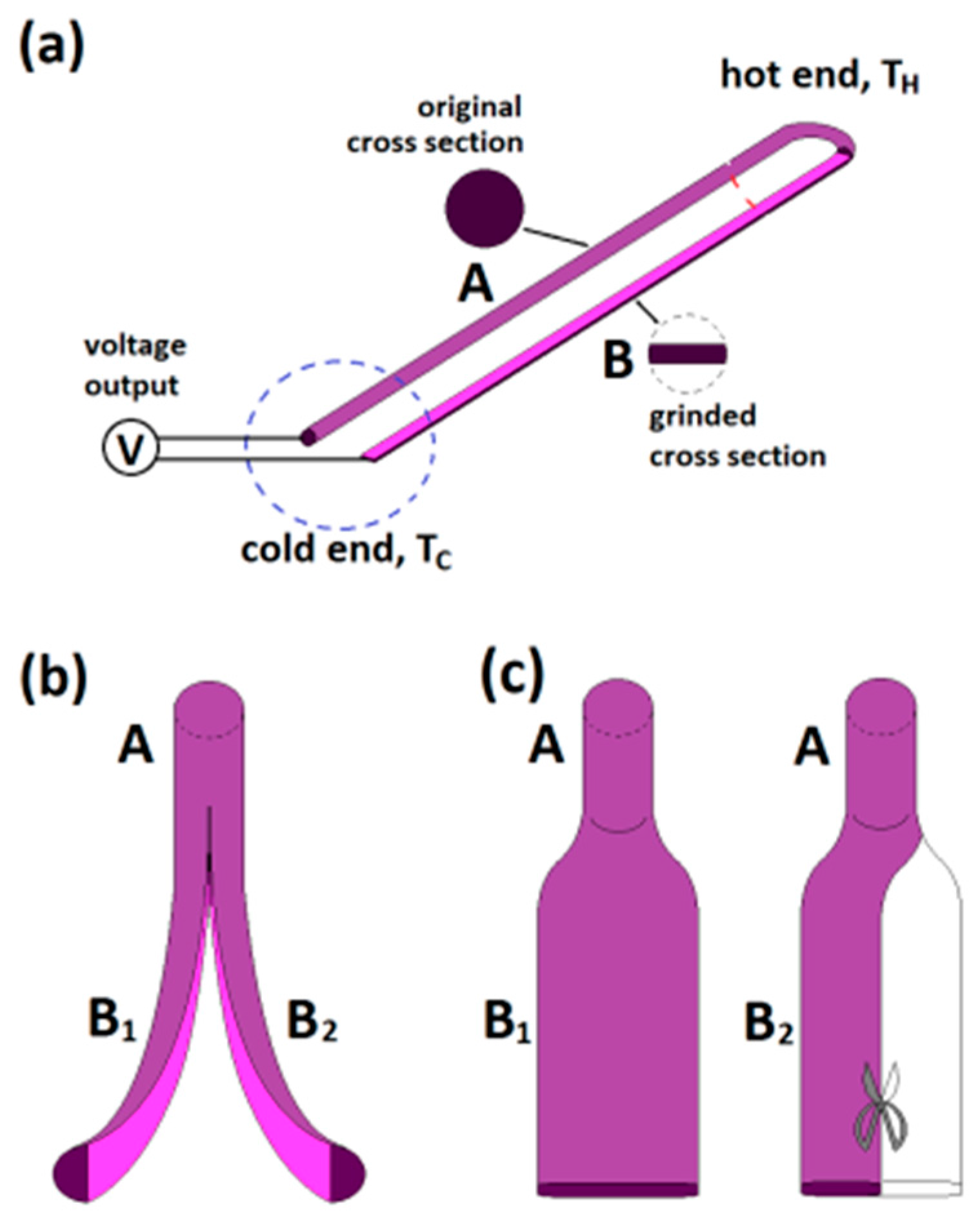
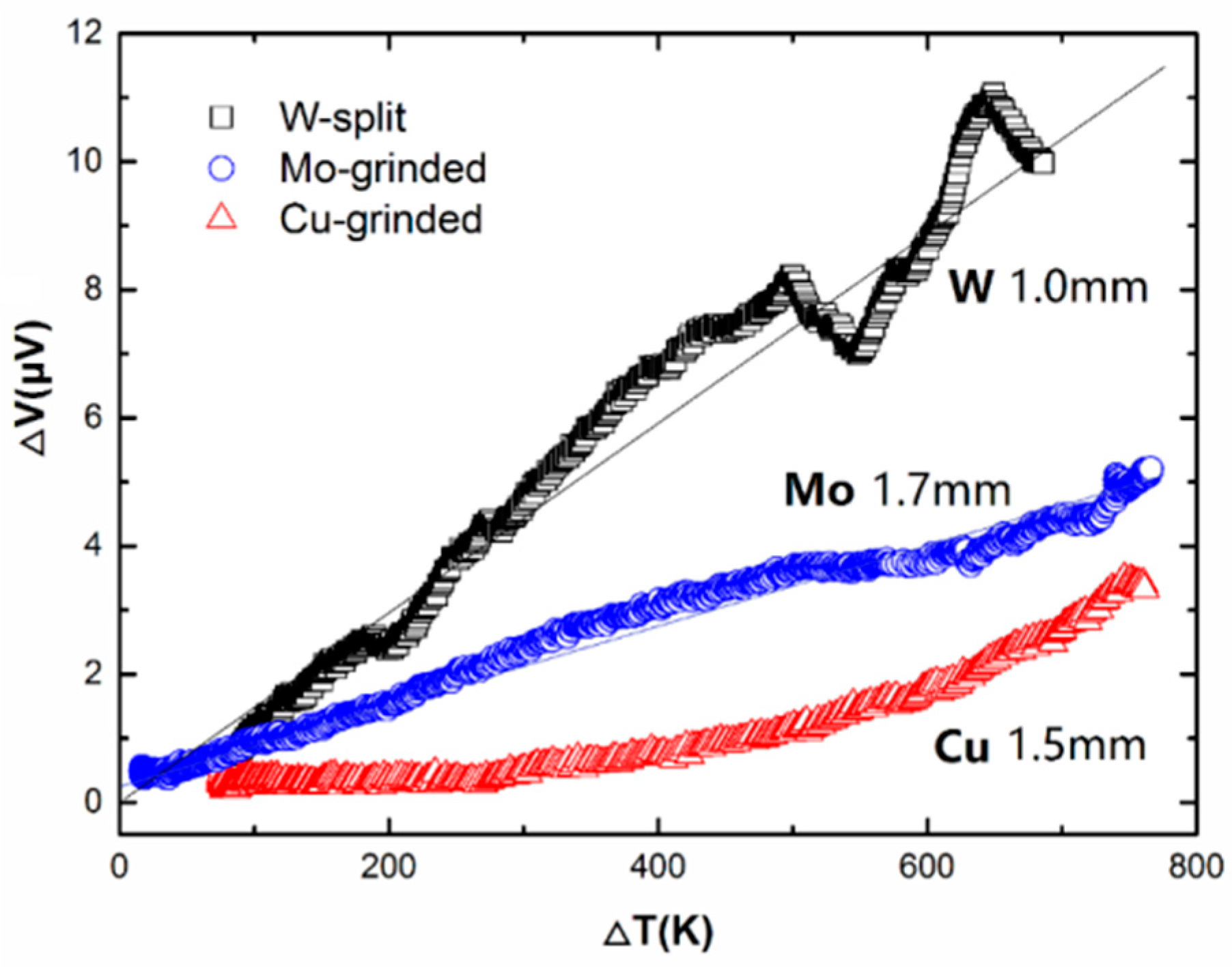
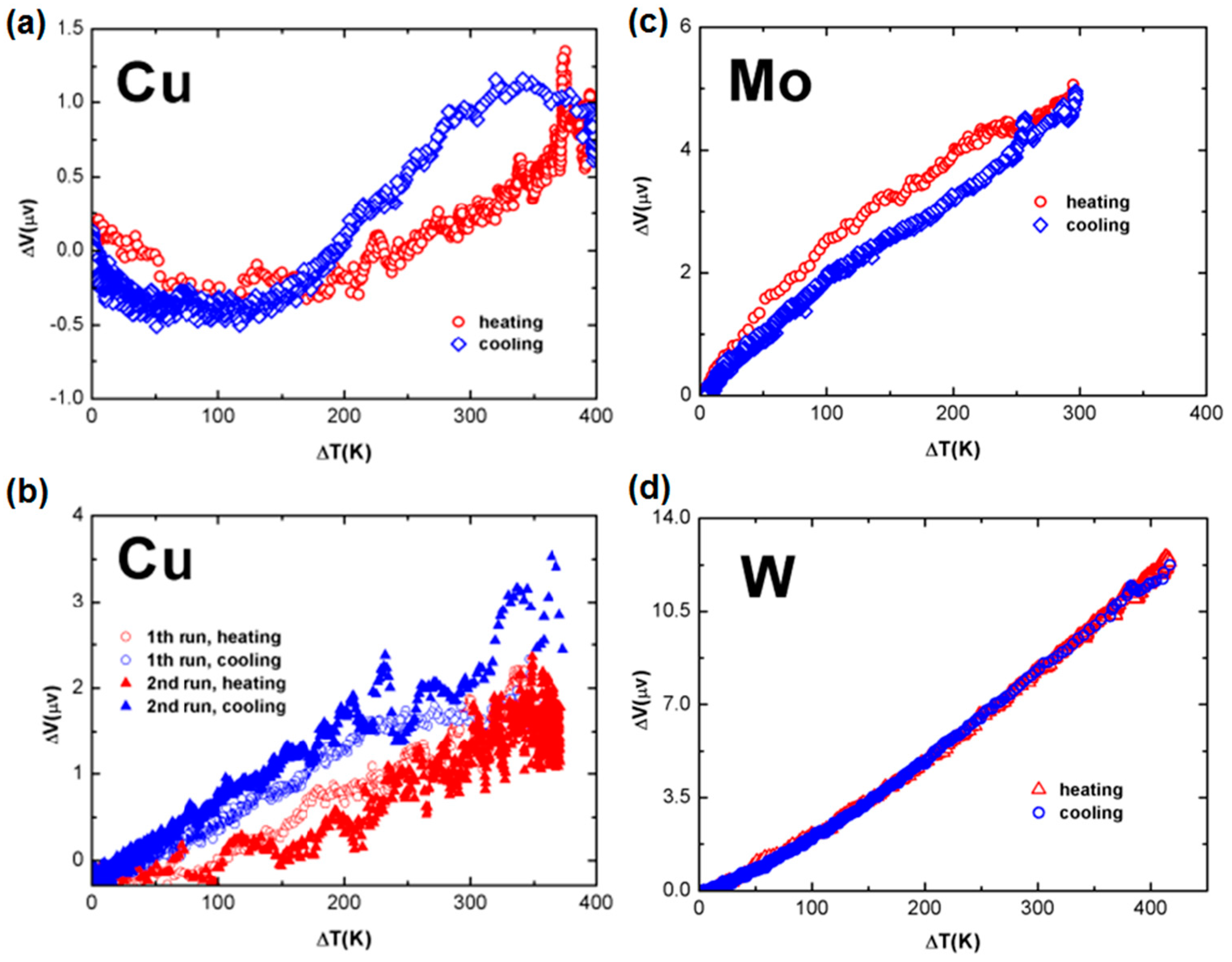
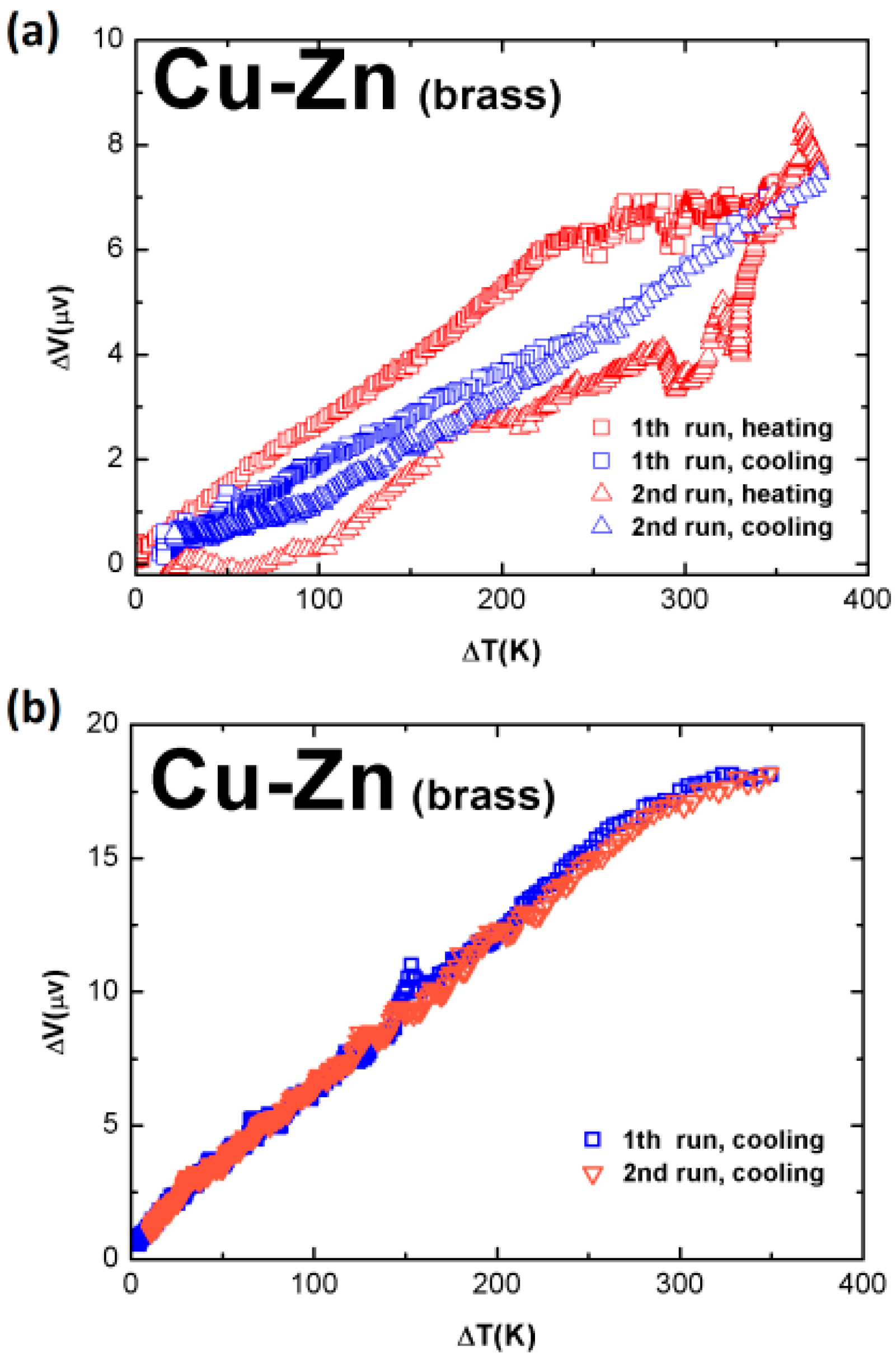

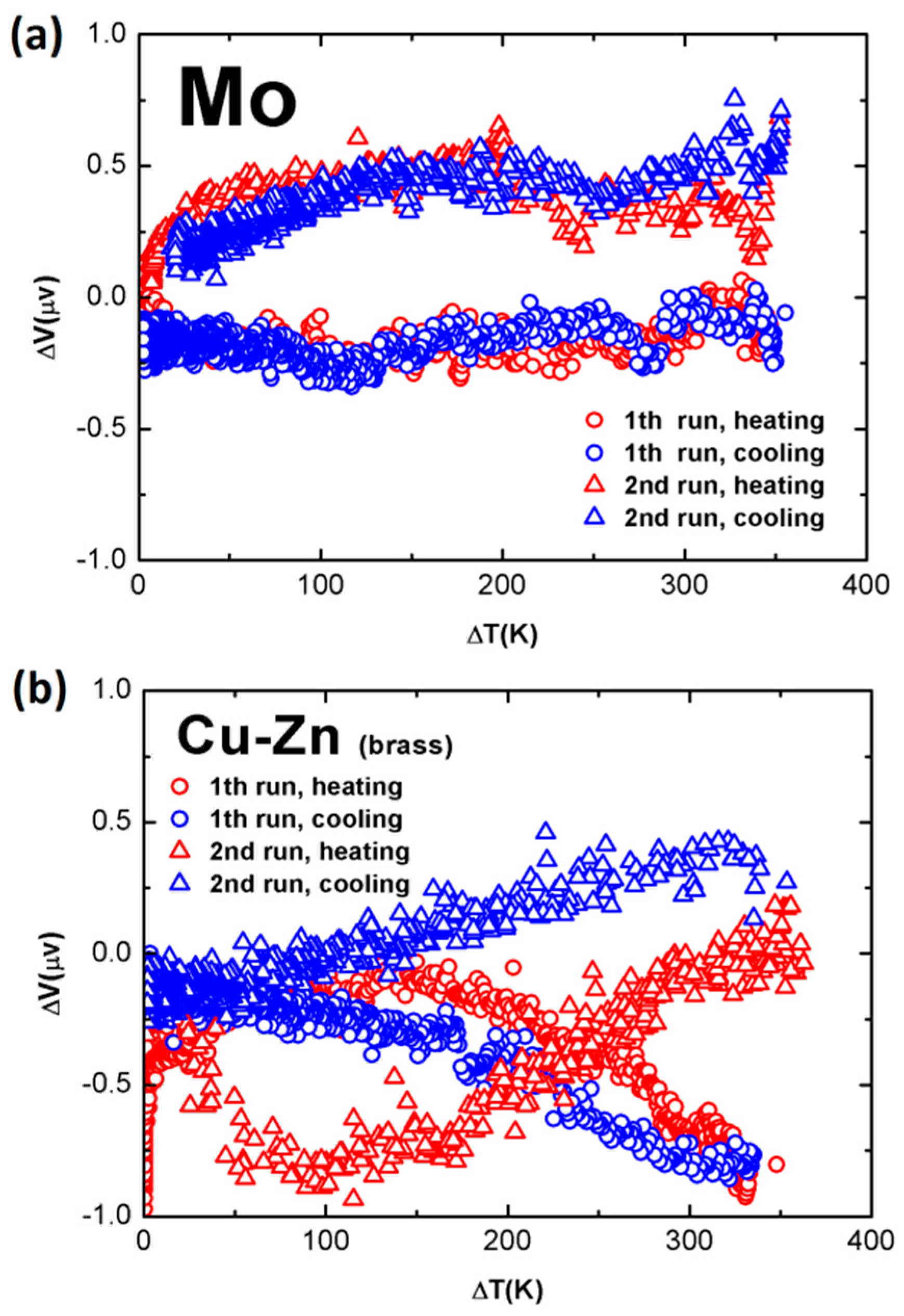
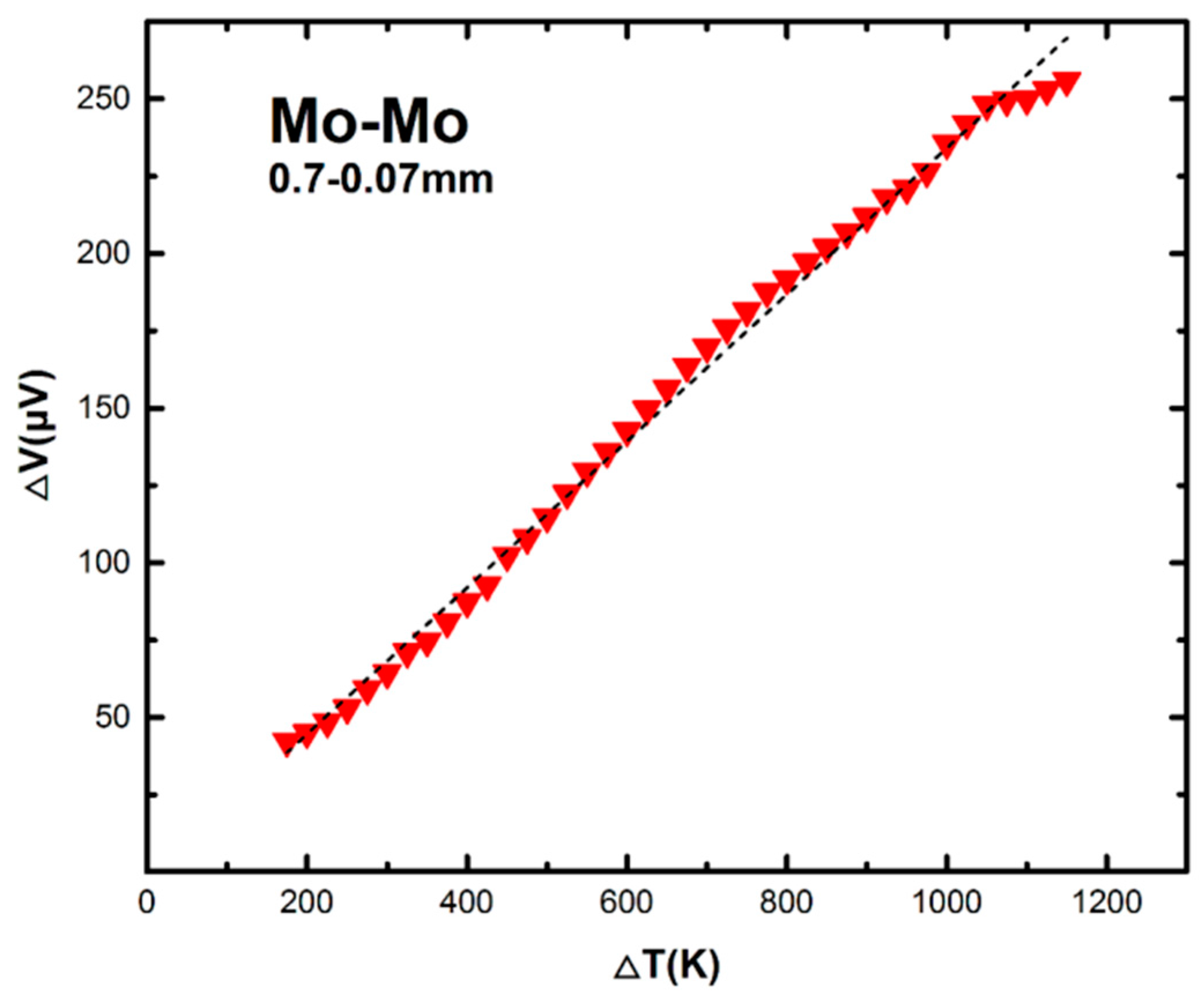
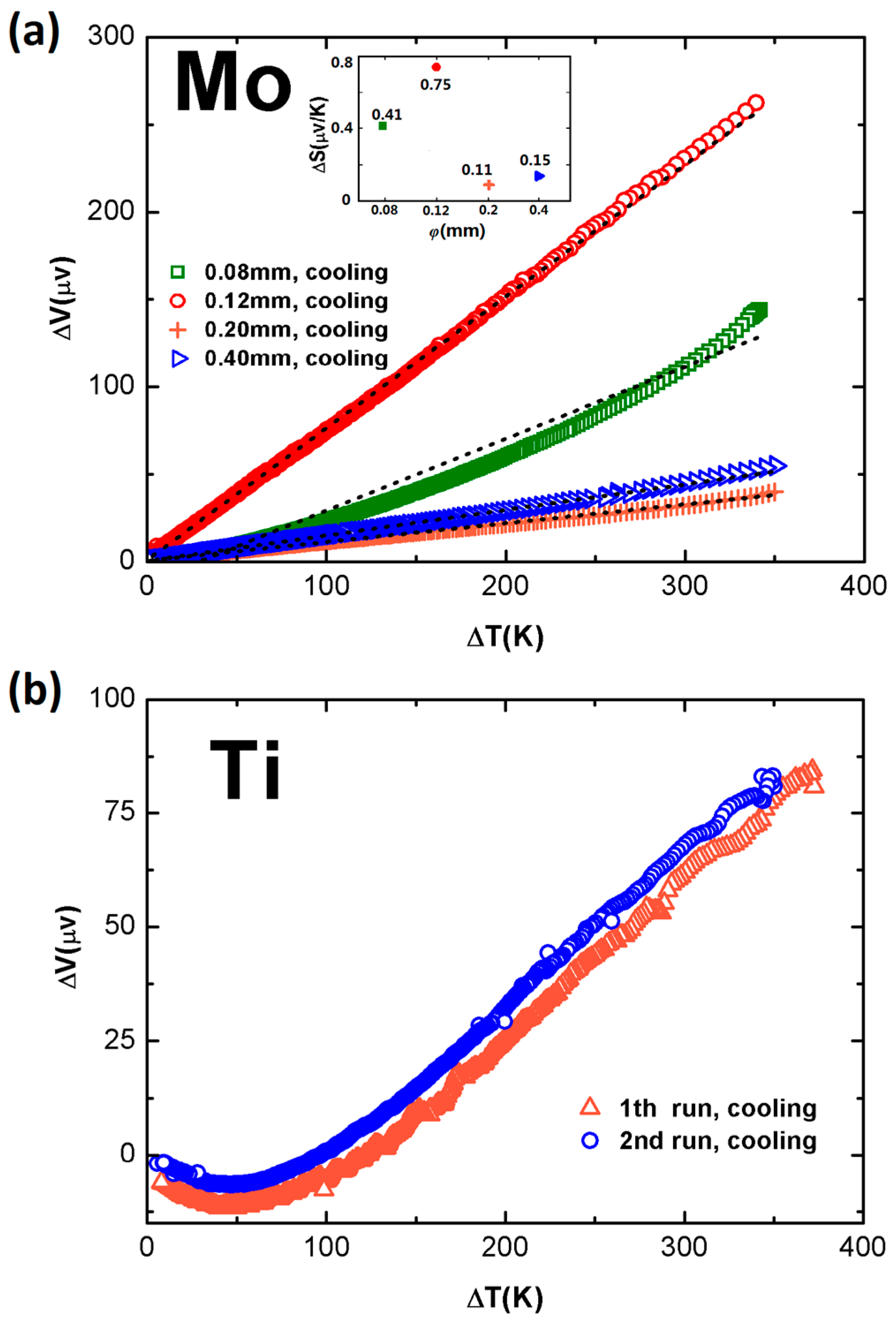
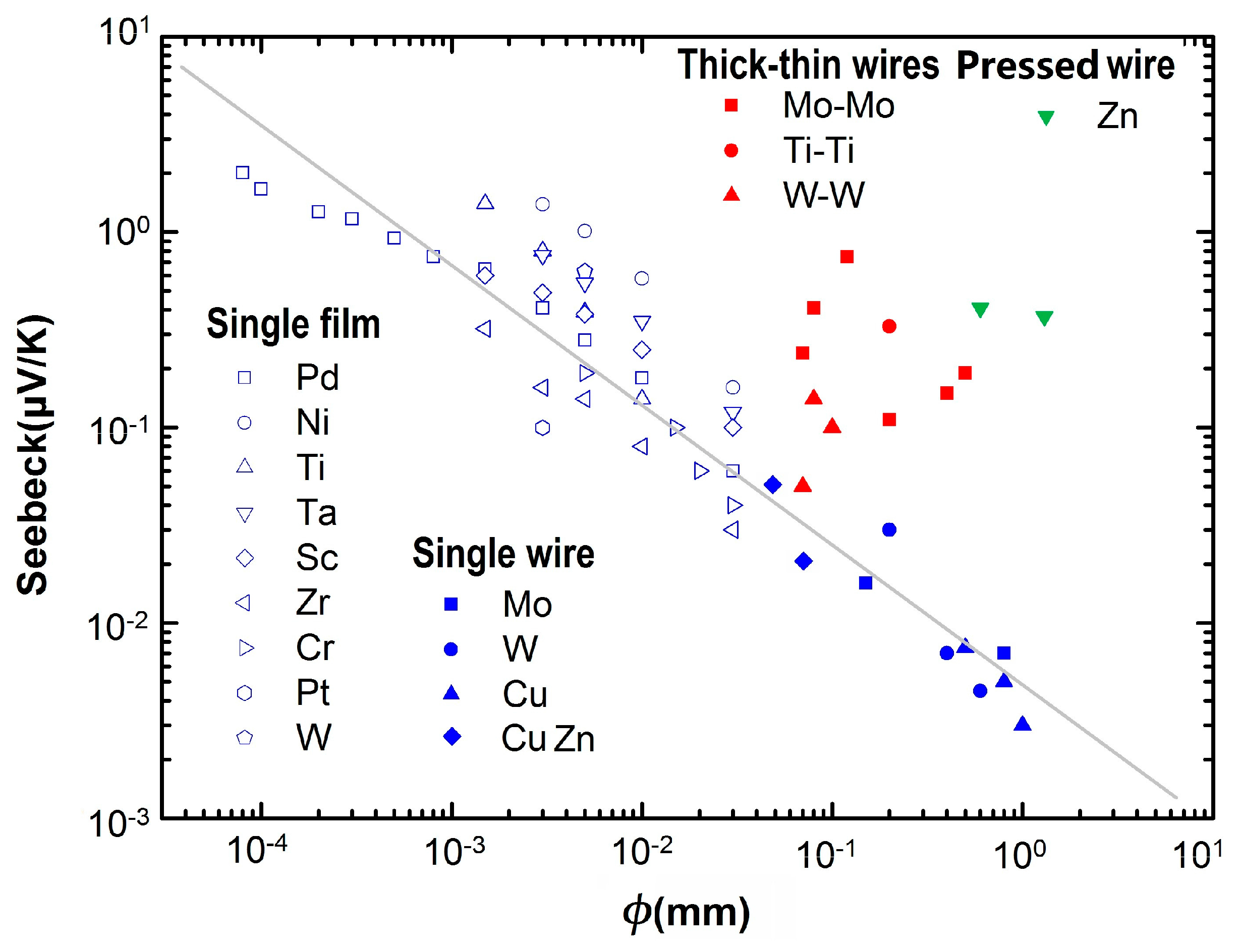
| Wire Material | W | Mo | Ti | Zn | Cu | Brass | |
|---|---|---|---|---|---|---|---|
| Main ingredient (greater than or equal to) % | 99.95 | 99.95 | 99.9 | 92.66 | 99.9 | Cu | Zn |
| 63.58 | 36.4 | ||||||
© 2017 by the authors. Licensee MDPI, Basel, Switzerland. This article is an open access article distributed under the terms and conditions of the Creative Commons Attribution (CC BY) license ( http://creativecommons.org/licenses/by/4.0/).
Share and Cite
Li, G.; Su, X.; Yang, F.; Huo, X.; Zhang, G.; Xu, S. Geometric Shape Induced Small Change of Seebeck Coefficient in Bulky Metallic Wires. Sensors 2017, 17, 331. https://doi.org/10.3390/s17020331
Li G, Su X, Yang F, Huo X, Zhang G, Xu S. Geometric Shape Induced Small Change of Seebeck Coefficient in Bulky Metallic Wires. Sensors. 2017; 17(2):331. https://doi.org/10.3390/s17020331
Chicago/Turabian StyleLi, Gang, Xiaohui Su, Fan Yang, Xiaoye Huo, Gengmin Zhang, and Shengyong Xu. 2017. "Geometric Shape Induced Small Change of Seebeck Coefficient in Bulky Metallic Wires" Sensors 17, no. 2: 331. https://doi.org/10.3390/s17020331






